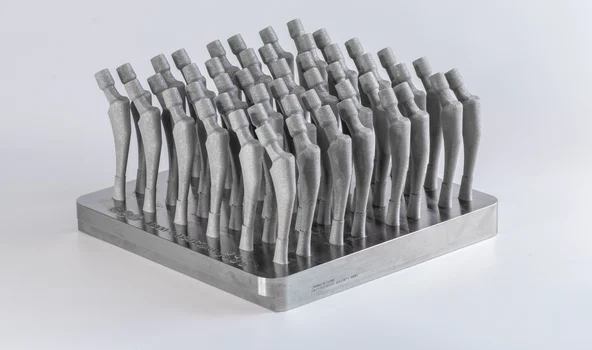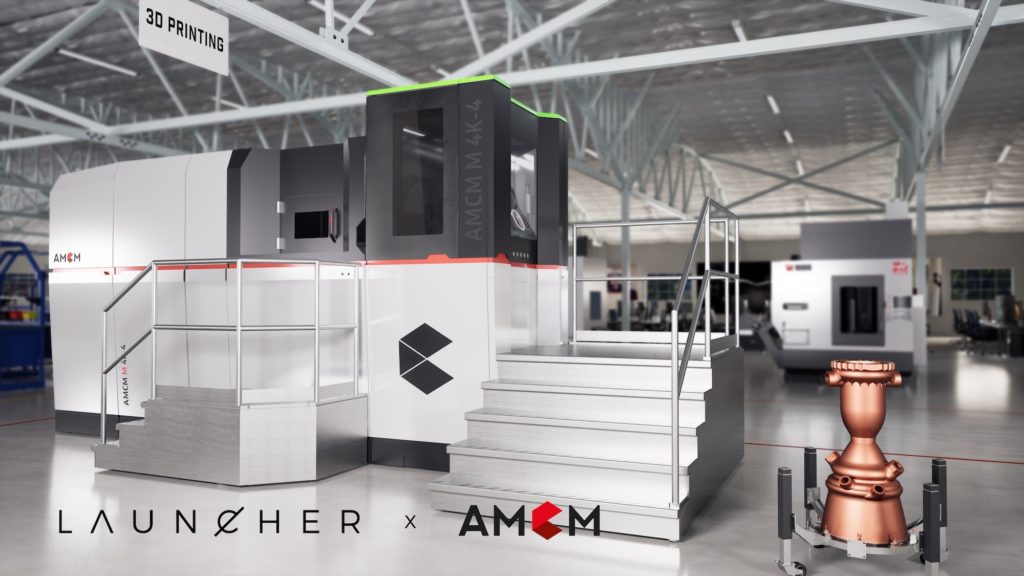German 3D printer manufacturer EOS is not only a pioneer in the additive manufacturing (AM) industry, but it also maintains the market share for metal 3D printing with its own take on laser powder bed fusion (LPBF) technology. However, the industry is rapidly changing, with competition coming in the form of an increasing number of metal LPBF machine makers and large conglomerates upping their stakes in the metal AM sector.
At the 2023 Additive Manufacturing Users (AMUG) Conference, we had the chance to sit down with the EOS team to learn about how the pioneer remains nimble amid this competitive landscape. Greg Hayes, Senior Vice President of Applied Technology, and Michael Wohlfart, Senior Additive Manufacturing Consultant, indicated that part of the answer lays in the research and development expertise of the company, as well as its organizational structure.
“Support-Free” Metal 3D Printing
Thanks to the introduction of Silicon Valley startup Velo3D (NYSE: VLD) to the market, the concept of “support-free” metal 3D printing has become a hot topic in the world of LPBF. This is because support structures are a key hassle when it comes to parts made with the technology and Velo3D’s initial marketing campaigns showcased the ability of its machines to 3D print metal components without supports. In turn, other LPBF machine makers had to show the public that they too could achieve “support-free” 3D printing.

In 2020, EOS published a blog post about the 3D printing of hip stem implants made using 3D printed holders rather than support structures to provide protection against the recoater forces of the printer. Image courtesy of EOS.
What has become clear more recently is that most, if not all, LPBF machines could potentially be used to produce parts without the use of support structures, but that their strategy isn’t always made public. At the 2022 RAPID+TCT show, for instance, AddUp had displayed several metal items 3D printed without the use of supports. More recently, EOS has launched its own marketing campaign devoted to the topic.
“One thing that I always like to remind myself is that the physics of the process is exactly the same as how it was three years ago, how it was two years ago, and how it is now with these new tools,” Greg Hayes explained. “For the past several years, many companies have been talking about being able to build support-free. You can’t trick physics. The process is what the process is, which means that, if you can build support-free on one system, you can also build support-free on another system. The unique difference is how you control the process to be able to build support free.”
In most cases, support-free 3D printing is accomplished by drastically slowing down the print process or by pre-calculating a build and addressing specific areas of a specific geometry. However, in the case of EOS, it’s the result of a new software solution: Smart Fusion, which the company is releasing at this year’s RAPID+TCT event—and it’s not just about eliminating support structures. It’s also about the much larger and more important issue of in-process quality control.

Stator rings 3D printed from 316L without supports. Image courtesy of EOS.
“It’s not only the support-free stuff that is interesting, but also the technology we use. It is the most powerful active feedback loop that has been implemented in a commercial product so far,” Wohlfart said.
He went on to explain that, using the EOSTATE ExposureOT Monitoring System, it is possible to capture light emissions from the melt pool in the printer. Measuring the light emissions, it’s possible for Smart Fusion to automatically detect overheating and then adjust the process parameters in the subsequent layer.
“By avoiding overheating, you have eliminated one of the biggest factors for why you would need supports,” Wohlfart said. “So, we can dramatically reduce supports that you would just need to increase heat transfer in overhanging regions of the parts. Another reason for supports would be compensation for residual stress because of the welding process. We have also seen that, if we avoid overheating, the residual stress becomes lower. The best part is that it’s automated, so it doesn’t require a lot of adjustments by the user.”
In other words, EOS has developed a tool for improving build outcomes altogether in an automated fashion. Support-free 3D printing just so happens to be a side benefit. And it is able to achieve this without slowing down the build rate of the equipment at all.
A Changing Metal 3D Printing Market
It’s not just the ability to 3D print without supports that is shaking up the metal AM industry, however. Given the current economic climate and Nikon’s acquisition of SLM Solutions, the scent of mergers and acquisitions is in the air. How will EOS fare? Hayes was quick to point out the legacy behind the German stalwart.
“We’re family owned. The answer hasn’t changed for the past 32 years and there’s no intention to sell to or be acquired by a larger organization. That’s a decision for the Langer family to make—really not anyone sitting at this table,” Hayes laughed. “But in all of our planning, there’s no intention for being acquired. We’re actually really proud of how our organization has been able to grow and even sustain growth over the past couple years. I don’t even think we stopped for a second and thought, ‘How are we going to fight against Nikon? Or how are we going to deal with this new company that’s bubbling up? Our conversations are more along the lines of: , how is this new company going to help us grow the industry we’re in? We’re in industry growth mode truly as everything we do. And at the end, we’re trying to secure that piece of the pie for EOS. But I think it’s a waste of calories to fight each other, right? We should be growing the industry.”
The legendary Langer family that founded and owns EOS may not be interested in selling to a corporate behemoth lurking in the shadows and waiting to pounce into AM. As the industry expands quickly (expected to reach $25 billion by 2025, according to SmarTech Analysis), will EOS then grow just as fast? We can imagine that the firm could acquire its fair share of businesses or merge with another AM stalwart—though I would guess an offer from Nano Dimension wouldn’t be considered too seriously.

Launcher acquired an AMCM M 4K for its California production facility. Image courtesy of AMCM/Launcher.
Hayes pointed out that EOS may not need to build up its own relative size in order to remain the market leader. For instance, EOS will not be releasing its own large-scale metal 3D printer under the traditional EOS brand, as it already does that through AMCM. The EOS subsidiary was an early innovator in 3D printing for space applications and continues to be a large supplier to the new space market.
Meanwhile, AM Ventures, an independent firm that was launched with seed investment from the Langer family, has built out a portfolio of startups that offer a variety of unique capabilities to the 3D printing market. Their focus ranges from orthodontic solutions and manufacturing execution software to electric motor components and micro metal 3D printing. As stand-alone businesses, they operate flexibly in the market, but they can also act as crucial business partners for EOS.

Algorithmically engineered aerospike rocket engine printed in copper at AMCM. Image courtesy of AMCM/EOS/Hyperganic.
DyeMansion is a case in point. The post-processing startup has been important for EOS customers who need to finish their polymer printed parts, but Stratasys has also taken to DyeMansion’s technology for its own polymer PBF technology. Meanwhile, in at least one case, an EOS competitor, 3D Systems, has acquired an AM Ventures business, Additive Works.
Because there is no formal relationship between the portfolio businesses and EOS, they are able to move freely in the AM space. However, they and EOS’s other operations may give the German stalwart the nimbleness to adapt to the industry as it continues to change shape in a post-COVID environment.
Hayes concluded the interview summing the sector up this way:
“Four years ago, we were talking about globalization and outsourcing and distributed manufacturing, right? Now, we’re talking about reshoring and workforce development. And if we talk about distributed manufacturing, it’s distributed withina known ecosystem with security at top of mind. It’s a different world now and it’s a world in which additive manufacturing has a very strong place. We plan on surfing that wave as best we can.”
Subscribe to Our Email Newsletter
Stay up-to-date on all the latest news from the 3D printing industry and receive information and offers from third party vendors.
You May Also Like
Profiling a Construction 3D Printing Pioneer: US Army Corps of Engineers’ Megan Kreiger
The world of construction 3D printing is still so new that the true experts can probably be counted on two hands. Among them is Megan Kreiger, Portfolio Manager of Additive...
US Army Corps of Engineers Taps Lincoln Electric & Eaton for Largest 3D Printed US Civil Works Part
The Soo Locks sit on the US-Canadian border, enabling maritime travel between Lake Superior and Lake Huron, from which ships can reach the rest of the Great Lakes. Crafts carrying...
Construction 3D Printing CEO Reflects on Being Female in Construction
Natalie Wadley, CEO of ChangeMaker3D, could hear the words of her daughter sitting next to her resounding in her head. “Mum, MUM, you’ve won!” Wadley had just won the prestigious...
1Print to Commercialize 3D Printed Coastal Resilience Solutions
1Print, a company that specializes in deploying additive construction (AC) for infrastructure projects, has entered an agreement with the University of Miami (UM) to accelerate commercialization of the SEAHIVE shoreline...





























